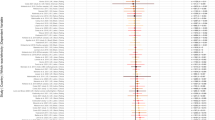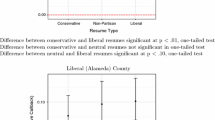Abstract
Voters in the Associated Press college basketball poll vote own-state teams and teams that are fewer miles away to higher rankings than other teams, especially at the bottom of their ballots. Game outcome data show evidence that teams that are fewer miles away are underrated — not overrated — by pollsters, especially at the top of their rankings, perhaps because pollsters fear accusations of geographic bias. When controlling for distance between pollsters and teams, there is some evidence that pollsters overrate local conference teams at the top of their ballots, but more properly rate them the bottom of their ballots.




Similar content being viewed by others
Notes
Aigner and Cain [1977] insist that mistake-based discrimination differs from information-based discrimination because systemic inaccuracies about certain groups cannot survive in a competitive marketplace, but Romer [2006] finds that systemic failures to optimize do indeed exist in competition.
Other sources of discrimination in polls have been found as well: Mirabile and Witte [2010] find that coaches voting in the 2004–2008 USA Today Polls ranked opponents of their alma mater to higher rankings than other teams.
There were 65 pollsters at any point in the season, but 66 pollsters overall. Patrick Stevens of The Washington Times was dismissed as a pollster after the Times shut down its sports section. This occurred after the 9th poll of the season had been released. He was replaced by John McNamara of The Capital in Annapolis, Maryland.
The USA Today Coaches Poll determines one-third of the BCS standings, which determines who plays in the national championship game (see http://www.bcsknowhow.com/bcs-formula). Dummett [1998] shows how pollsters can manipulate Borda count polls.
The National Collegiate Athletics Association (NCAA) post-season tournament had 65 teams in the 2009–2010 season. Since 2010–2011 it has had 68 teams [Prisbell and Yanda 2010]. Coleman et al. [2010] find that the Sagarin Computer Poll ranking can affect the seeding of NCAA tournament teams, but find no evidence it affects whether a team makes the tournament or not.
This difference between college football and college basketball may be mitigated if college football pollsters are subject to more oversight or public scrutiny than college basketball pollsters.
College basketball polls also appear to have been the subject of much less research than college football polls. A large, multi-disciplinary bibliography of research regarding college football rankings can be found at http://homepages.cae.wisc.edu/~dwilson/rsfc/rate/biblio.html.
The three pollsters situated in Washington DC are included as being in Virginia and Maryland as well as Washington DC.
Distances are measured via the zip codes of universities and pollsters’ employers. They account for curvature of the earth.
Kate Hairopolous of The Dallas Morning News was the only female of the 66 pollsters in 2009–2010.
A t subscript could feasibly be included in the subscripts for X ip and σ p because the population of pollsters changed over the course of the season (see fn 1).
There are 130 fewer observations in the Columns 1–2 of Table 2 than in Panel A of Table 1 because twice during the season all 65 first-place votes went to the same team (Kansas). These 130 observations were removed because the team-week fixed effect coefficient was beyond the upper-level censor and not identified, and the team’s inclusion provided no extra information to the estimation.
This contrasts with Coleman et al. [2010], who found distance to be insignificantly related to votes in the AP College Football Poll.
Wooldridge [2002] shows how to create a predicted value from a one-sided Tobit. Creating a predicted value from a two-sided Tobit is an extension of the model.
In the bottom-half sample estimation, B ipt in equation (3) is upper-bounded at 13.
Coleman [2005] also discusses “retrodictive accuracy,” by which poll accuracy is measured vis-à-vis how well it reflects completed team performance over the course of a season.
Having separate controls for the better-ranked and worse-ranked teams is similar to gravity models where migration can vary with the characteristics of both origin and destination cities (e.g., Fields 1976).
Among games included in the sample, the mean value of WORSE_RANK differs slightly between Panel A and Panel B. This is because not every Panel A game involving two ranked teams is observed in Panel B. In some games between, for example, Teams A and B, Team A is ranked above Team B in all observations where both are ranked, but Team B is ranked in some polls where Team A is unranked. Thus, when removing unranked observations from the data set, the remaining observations are perfectly classified and are omitted from the estimations.
The rank coefficients themselves (not shown) confirm that rankings are more accurate at the top of the rankings than at the bottom of the rankings.
In Column 2, CONFERENCE_MATCH_BETTER*BETTER_RANK is positive at the 13 percent level.
Estimations were also performed where own-state teams are counted as conference-affiliated teams, and the controls for STATE_MATCH_BETTER, STATE_MATCH_WORSE, and their interaction were removed from the sample. The sum of the three CONFERENCE coefficients was significant at the 15 percent level when omitting games involving unranked teams.
For examples, see John Feinstein’s website (http://www.feinsteinonthebrink.blogspot.com) or John Wilner’s blog (http://blogs.mercurynews.com/collegesports).
References
Ai, Chunrong, and Edward C. Norton . 2003. Interaction Terms in Logit and Probit Models. Economics Letters, 80 (1): 123–129.
Aigner, Dennis J., and Glen G. Cain . 1977. Statistical Theories of Discrimination in Labor Markets. Industrial and Labor Relations Review, 30 (2): 175–187.
Altonji, Joseph G., and Charles R. Pierret . 2001. Employer Learning and Statistical Discrimination. The Quarterly Journal of Economics, 116 (1): 313–350.
Becker, Gary . 1957. The Economics of Discrimination. Chicago: The University of Chicago Press.
Bertrand, Marianne, Dolly Chugh, and Sendhil Mullainathan . 2005. Implicit Discrimination. American Economic Review, 95 (2): 94–98.
Burdekin, Richard C. K., Richard T. Hossfeld, and Janet Kiholm Smith . 2005. Are NBA Fans Becoming Indifferent to Race? Evidence From the 1990s. Journal of Sports Economics, 6 (2): 144–159.
Campbell, Noel D., Tammy M. Rogers, and R. Zachary Finney . 2007. Evidence of Television Exposure Effects in AP Top 25 College Football Rankings. Journal of Sports Economics, 8 (4): 425–434.
Coleman, B. Jay 2005. Minimizing Game Score Violations in College Football Rankings. Interfaces, 35 (6): 483–496.
Coleman, B. Jay, Andres Gallo, Paul M. Mason, and Jeffrey W. Steagall . 2010. Voter Bias in the Associated Press College Football Poll. Journal of Sports Economics, 11 (4): 397–417.
Dummett, Michael . 1998. The Borda Count and Agenda Manipulation. Social Choice and Welfare, 15 (2): 289–296.
Fowdur, Lona, Vrinda Kadiyali, and Jeffrey Prince . 2012. Racial Bias in Expert Quality Assessment: A Study of Newspaper Movie Reviews. Journal of Economic Behavior and Organization, 84 (1): 292–307.
Gneezy, Uri, John List, and Michael K. Price . 2012. Toward an Understanding of Why People Discriminate: Evidence from a Series of Natural Field Experiments. NBER Working Paper No. 17855. Cambridge, MA: National Bureau of Economic Research.
Hausman, Jerry A., and Paul A. Rudd . 1987. Specifying and Testing Econometric Models for Rank-ordered Data. Journal of Econometrics, 34 (1–2): 83–104.
Holzer, Harry J., and Keith R. Ihlanfeldt . 1998. Customer Discrimination and Employment Outcomes for Minority Workers. The Quarterly Journal of Economics, 113 (3): 835–867.
Holzer, Harry J., Stephen Raphael, and Michael A. Stoll . 2006. Perceived Criminality, Criminal Background Checks, and the Racial Hiring Practices of Employers. Journal of Law and Economics, 44 (2): 451–480.
LeSage, James, and Robert Kelly Pace . 2009. Introduction to Spatial Econometrics. London: Chapman & Hall.
Levitt, Steven D. 2004. Testing Theories of Discrimination: Evidence from Weakest Link. Journal of Law and Economics, 47 (2): 431–453.
List, John A. 2004. The Nature and Extent of Discrimination in the Marketplace: Evidence from the Field. The Quarterly Journal of Economics, 119 (1): 49–89.
Logan, Trevon D. 2007. Whoa, Nellie! Empirical Tests of College Football’s Conventional Wisdom. NBER Working Paper 13596. Cambridge, MA: National Bureau of Economic Research.
Mandel, Stewart . 2005. The Real BCS Controversy: Want Evidence of Bias? Just Look at Coaches’ Votes. SI.com, 7 December.
Mirabile, McDonald Paul, and Mark David Witte . 2010. Not So Fast, My Friend: Biases in College Football Polls. Journal of Sports Economics, 11 (4): 443–455.
Morris, Stephen . 2001. Political Correctness. Journal of Political Economy, 109 (2): 231–265.
Nutting, Andrew W. 2011. And After That, Who Knows?: Detailing the Marginal Accuracy of Weekly College Football Polls. Journal of Quantitative Analysis in Sports, 7 (3), doi:10.2202/1559-0410.1274.
Parsons, Christopher A., Johan Sulaeman, Michael C. Yates, and Daniel S. Hamermesh . 2011. Strike Three: Discrimination, Incentives, and Evaluation. American Economic Review, 101 (4): 1410–1435.
Price, Joseph P., and Justin Wolfers . 2010. Racial Discrimination Among NBA Referees. Quarterly Journal of Economics, 125 (4): 1859–1877.
Prisbell, Eric, and Steve Yanda . 2010. NCAA Men’s Tourney Will Expand to 68; Three Teams Added in 14-year, $10.8 Billion Deal Reached With CBS, Turner. The Washington Post, 23 April: D-1.
Romer, David . 2006. Do Firms Maximize? Evidence from Professional Football. Journal of Political Economy, 114 (2): 340–365.
Ross, Justin M., Sarah E. Larson, and Chad Wall . 2012. Are Surveys of Experts Unbiased? Evidence from College Football Rankings. Contemporary Economic Policy, 30 (4): 502–522.
Steinberg, Dan . 2007. The AP’s AU Voter: John Feinstein. Washington Post DC Sports Bog, 28 December.
Stone, Daniel F. 2013. Testing Bayesian Updating with the Associated Press Top 25. Economic Inquiry, 51 (2): 1457–1474.
Stone, Daniel F., and Basit Zafar . forthcoming. Do We Follow Others When We Should Outside the Lab? Evidence from the AP Top 25. Journal of Risk and Uncertainty, accepted.
Wolfers, Justin . 2006. Diagnosing Discrimination: Stock Returns and CEO Gender. Journal of the European Economic Association, 4 (2/3): 531–541.
Wolfers, Justin, and Alok Kumar . 2008. Do Male Analysts, Mutual Fund Managers, and Individual Investors Discriminate Against Female CEOs? Working Paper, University of Pennsylvania, Philadelphia, PA.
Wooldridge, Jeffrey M. 2002. Econometric Analysis of Cross-Section and Panel Data. Cambridge, MA: MIT Press.
Acknowledgements
The author wishes to especially thank Daniel F. Stone for comments on earlier drafts. The author also wishes to thank audiences at Washington State University and anonymous referees for comments.
Author information
Authors and Affiliations
Appendices
Appendix A
Appendix B
Rights and permissions
About this article
Cite this article
Nutting, A. Discrimination and Information: Geographic Bias in College Basketball Polls. Eastern Econ J 42, 80–103 (2016). https://doi.org/10.1057/eej.2014.41
Published:
Issue Date:
DOI: https://doi.org/10.1057/eej.2014.41




